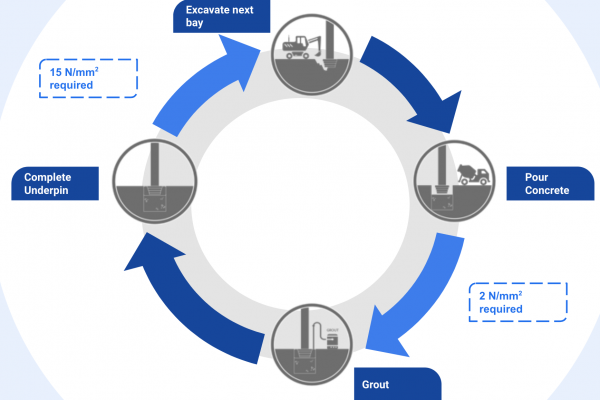By investing in real-time concrete strength data, Taylor Woodrow (a Vinci Group Company) and subcontractor Joseph Gallagher were able to save two weeks on the delivery of London Overground’s White Hart Lane station upgrade.
“The live data allowed us to work continuously without ever waiting for the right strength result. In the end, we finished 2 weeks ahead.”
April 2019 marked the opening of the 62,303 seater Tottenham Hotspur Stadium, the new home to Spurs players and fans alike. With matchday peak throughput at the stadium’s closest rail station – White Hart Lane – set to increase from 7,455 to 12,395, crucial improvements including a new western entrance, ticket hall, and two underpasses to provide thoroughfare beneath the railway arches, were required.
Prior to constructing the underpasses, the archway piers needed underpinning to prevent any movement that might compromise the structure of the viaduct supporting the rail.
Underpinning the pier foundations without compromising the integrity of the viaduct supporting a live railway, on a small site, within tight programme constrains was a complex engineering challenge that required a precise construction sequence.
Each pier was underpinned in up to 8 bays. First, a bay was excavated, then filled with rapid-curing concrete which would need to reach a strength of 2MPa before injecting grout to fill any small remaining spaces between the surfaces of the concrete and original foundations. To prevent ground movement, the previously concreted bay needed to have achieved at least 15MPa before excavating the next.
With 40 bays to complete and two concrete strength hold points for each, concrete curing was without question on the critical path.

Converge were brought onto the project to provide the site team with real-time concrete strength data to unlock a ‘day shift – evening shift’ work sequence that would ultimately see all the underpins completed 2 weeks early.
The team would start each day shift by consulting the ConcreteDNA cloud platform to confirm the concrete poured the previous day had reached 15MPa. This milestone was generally exceeded overnight – reaching 15MPa after an average of just 8.8 hours.
Ivan Vladev, Senior Engineer at Taylor Woodrow, expressed that “having the strength notifications to hand before starting the shift allowed us to begin excavating immediately; decompressing the day’s programmed tasks and reducing the risk of overrun”.
After excavating and then pouring concrete, ConcreteDNA notified the team the instant 2MPa had been achieved so that grouting could begin in the evening shift. This occurred after an average of 6.2 hours.
“The early strength notifications provided [by ConcreteDNA] played a key role in constructing the underpins. To complete all the pins to the programme we couldn’t afford any delay at the start of the day shift or at handover to the evening shift. The live data allowed us to work continuously without ever having to wait for the right strength result. In the end, we finished 2 weeks ahead.”
Traditional concrete testing methods have latency built-in. When a cube is crushed on-site, you discover that you either waited longer than you needed before taking action or you’ll need to wait several hours longer and crush another cube.
If you’re using a concrete testing laboratory, there’s also logistics and communication that contribute to the delay.
Live concrete data eliminated latency at White Hart Lane, facilitated the shortest cycle possible which ultimately saved the team 2 weeks.
Often, several stakeholders are involved in quality assurance. At White Hart Lane, Joseph Gallagher, Taylor Woodrow, and London Overground all needed to be satisfied with the concrete strength before proceeding.
By presenting data in the cloud, ConcreteDNA allowed all stakeholders to assess concrete strength from any location (on or off-site), at any time and quickly come to a collaborative decision.
Ivan Vladev - Senior Engineer -“The early strength notifications provided played a key role in quickly constructing the underpins. To complete all the pins to the programme we couldn’t afford any delays at the start of each shift. The live data allowed us to work continuously without ever having to wait for the right strength result. In the end, we finished 2 weeks ahead.”